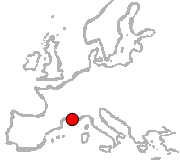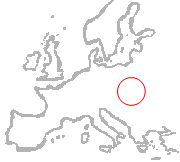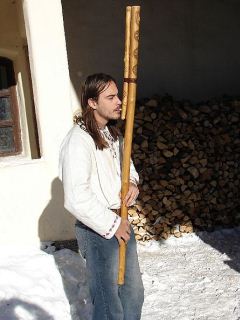
Population: 852,000
Location: Located on the southeast coast of France.
In 2013, Slovakia's second largest city Košice has been designated as European Capital of Culture (www.kosice2013.sk) as well as France's mediterranean port Marseille (www.mp2013.fr).


The music of Slovakia has been influenced both by the county's native Slovak peoples and the music of neighbouring regions. Whilst there are traces of pre-historic musical instruments, the country has a rich heritage of folk music and mediaeval liturgical music, and from the 18th century onwards, in particular, musical life was influenced by that of Austria-Hungary.
Bone pipes dating from the Early Bronze Age (about 3000 BC) have been found in the Nitra region, testifying to the early role of music in the Celtic 'Nitra Culture'. Such instruments were produced continuously, albeit with more sophistication, up to the medieaval period. Other early instruments found include drums dating back to the Palaeolithic period, iron and bronze bells from the 3rd or 4th century AD. Other folk instruments of the region whose early development must remain largely conjectural include the fujara and the Slovak versions of bagpipes and the jaw harp. They certainly existed in the 15th century.
In November 2005 the fujara (Slovak shepherds' pipe) and its music were named Masterpieces of the Oral and Intangible Heritage of Humanity by UNESCO.

From the mediaeval period onwards writers identify a number of principal streams of music in Slovakia. The principal classifications include church music, folk music, and instrumental music heard in towns and courts. Each of these has of course numerous subsidiary classifications.
Some of the oldest recorded forms of music in Slovakia are liturgical song (in Old Slavonic) from the time of Great Moravian empire (9th century), from which developed much of the sacred music of later centuries. Latin plainsong was also widespread in the region at this early period, especially after the incororation of Slovakia into the Kingdom of Hungary in 1218. Early codices include the 'Nitra Gospels' of c.1100, and the 'Pray codex' (c. 1195). From the 15th to the 17rh centuries, polyphony was practised and developed at many urban centres, including Bratislava, Bardejov, Levoča and Kežmarok.
In the first half of the 19th century, a national musical tradition began to develop around Slovakia’s impressive folk heritage. Modern Slovak music drew from both classical and folk styles. A key figure who began this fusion is Ján Levoslav Bella, born in Liptovský Mikuláš (1843–1936), a contemporary of Antonín Dvořák and Leoš Janáček. Slovak modes and melodies can be heard clearly in his third string quartet, as well as in many of his other works.
Marseille
Marseille is France's largest city on the Mediterranean coast and its largest commercial port. Founded by Greek settlers in the 7th century BC, the city today is formed by immigrants and a cultural mix and melting-pot typically found in seaports. Marseille had become home to musicians from around the globe - from Mahgreb rap and Algerian rai to Pacific creole and Congolese rumba music.
Marseille's musical calling card might be Moussu T e lei Jovents, founded by singer Tatou (Moussu T, i.e. Mister T) and guitarist and banjo player Blu, both internationally known artists from the Occitan-speaking ragamuffin band, Massilia Sound System.
The group performs original chanson and blues music, inspired by the Marseille of the 1930s, then a musical melting pot, where Provençal songs could be heard alongside local operettas, and black music such as blues and jazz as well as rhythms from the Caribbean and Brazil were breaking against European shores.
There are several popular festivals held throughout the year. The world music fair and showcase Babel Med Music is held annually in the docks of Marseille, its 9th edition from 21th to 23th March 2013. Babel Med Music is a marketplace for about 2,500 artists and business / cultural representatives as well as a three day festival for the general public, presenting 36 concerts in 2013.
Thanks to Marseille being European Capital of Culture in 2013, Babel Med Music introduces a particular stage dedicated to contemporary music and urban sounds from all around the Mediterranean. Artists featured are Italian vocalist Rosapaeda[34] and the Albanian Elina Duni Quartet,[36] as well as Arab musicians and Quebecois band De Temps Antan.[45]
From France there is the Pan-Mediterranean group Cie Rassegna,[29] electro-folk band D’aqui Dub, and trad band Du Bartàs[50] from the Languedoc region.
Since 1992, about 60,000 visitors gather in the Dock des Suds every year for the Fiesta des Suds. Its 22nd edition takes place from 18th to 26th October 2013.
In 1998, the Fiesta des Suds audience discovered the global beats of the Watcha Clan, introducing vocalist Sista K from mixed Ashkenazi, Sephardic and Berber ancestry. Dub, jungle, trance and hip-hop meet Balkan brass and klezmer music - blown on the winds across the waters from Algeria to Agadir to Andalucia, meeting in the Marseille melting pot.
Marseille is the capital of the Provence-Alpes-Côte d'Azur region. Historically, the Provence, the region of south eastern France adjacent to Italy, is the first Roman province beyond the Alps, their Provincia Romana. Therefore the most prominent characteristic of the region's folk music is an Italian musical influence.
Provençal folk music is known for ensembles of galoubets (three holed flute) and percussion, the rigaudon dance (originally a lively 17th-century dance for couples, similar but rhythmically simpler to that of a bourrée), as well as a distinct hurdy-gurdy tradition in Savoie and a choral tradition in the Alpes.
It is also the historical region of Occitania (lo País d'Òc) - roughly the southern half of France and smaller parts of Italy and Spain -, where Occitan was the main language spoken before the French conquest in the 1200s, and where it is sometimes still used.
The group Lo Còr de la Plana, founded in 2001, is devoted to revive and modernize traditional Occitan songs that until now have been confined to religious ceremonies. These six young singers from Marseille present polyphonic chant in the Occitan language, taking inspiration from Bartok to The Velvet Underground. Their music is accompanied only by foot-stomping, hand-clapping and the occasional percussion, such as the North African bendir and tamburello.
Košice
Košice (German: Kaschau) is a city in eastern Slovakia. It is situated on the river Hornád at the eastern reaches of the Slovak Ore Mountains, near the border with Hungary. With a population of approximately 240,000, Košice is the second largest city in Slovakia after the capital Bratislava.
The city had been founded by both German and Slav settlers and had a German majority until the mid 16th century. Subsequent Hungarization and Slovakization and deportation and killing of approximately 10,000 Jews during the German occupation in World War II shifted the balance of the town's population to those who claimed Slovak as their language and ethniticity.
Košice still is home of a large Roma minority. The town hosts the Divadlo Romathan, a professional Roma theatre founded in 1992 performing in both Romani and English language.
In 2012, the first Jewish culture festival in Slovakia, Mazal Tov!, was held in Košice. (Unfortunatly there are no signs of a sequel yet.)
Košice's Yiddish music heroes are the Kaschauer Klezmer Band, formed in 2001, led by clarinettist Vlado Sidimák and double bass player Palo Šalamon. In 2013, the KKB will play the Cassovia Folk Fest from 26th to 30th June 2013, alongside traditional fujara (shepherd's beak flute), gajdy (shepherd's bagpipes) and horn players and folklore ensembles from Slovakia, Hungary, Greece and Croatia.
In other respects, Košice is a poor area, economically and culturally, not very known for its arts scene (though Andy Warhol's parents were born not far from here). This year's events will include an all-day concert of Hungarian Music (8th September), a regional folk song competition (13th October), and the Košice Folklore Days with competitions, workshops and concerts for dancers and singers (15th to 24th November).
Photo Credits:
(1)-(4) Maps and Flags;
(5) Fujara
(by Wikipedia);
(6) Lo Còr de la Plana (by Folkwoods);
(7) Moussou T E Lei Jovents,
(8) Banda (from website).